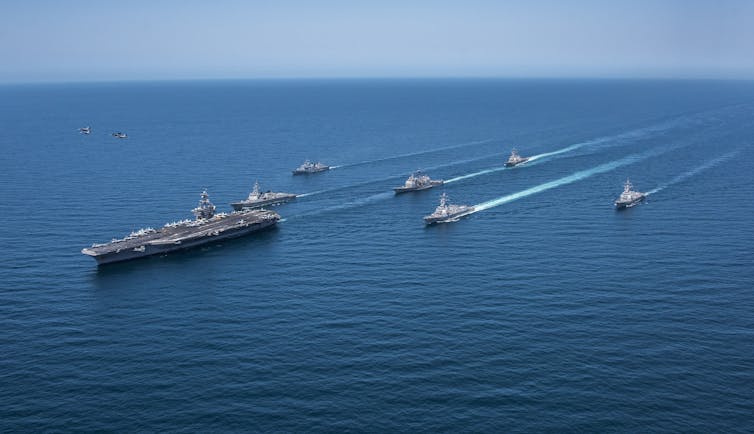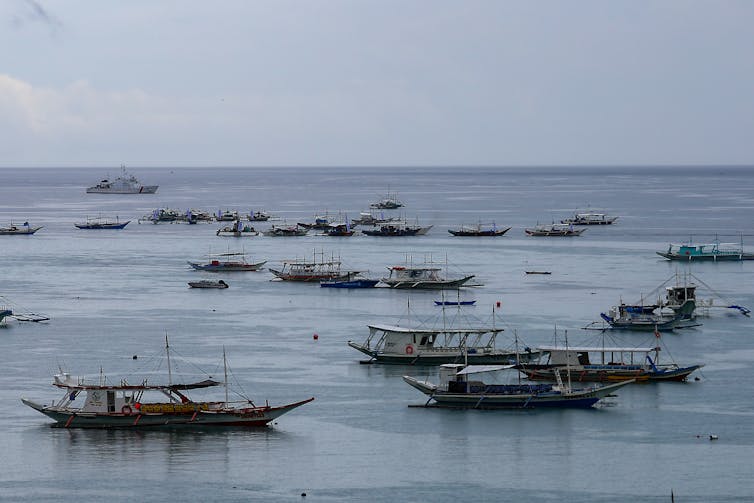Southeast Asian nations look to hedge their way out of troubled waters in the South China Sea
- Southeast Asian nations, including Vietnam, the Philippines, and Malaysia, are trying to navigate the complex geopolitical situation in the South China Sea, where China’s assertive claims have stirred up trouble.
- The region is characterized by a lack of coordination among ASEAN member states, with each nation charting its own course in response to China’s increasing militarization and expansion of its maritime claims.
- China’s nine-dash line claim has significant implications for the region, including major incursions into waters around Vietnam, the Philippines, and Malaysia, and poses a threat to the economic interests of these countries.
- Southeast Asian nations are adopting a “hedging” approach, maintaining good relationships with both China and the US without fully committing to one or the other, in an effort to avoid antagonizing either power.
- The future of the South China Sea remains uncertain, with tensions potentially rising as the region’s major powers continue to jockey for influence and control over this valuable biological resource and strategic waterway.

The South China Sea has long been a bubbling geopolitical hot spot. Recently, a series of moves by the various nations claiming a stake in the waters has stirred up yet more trouble.
Malaysia has of late reaffirmed its commitment to oil and gas exploration in waters claimed by China while quietly building up its military on the islands off Borneo.
Meanwhile, Chinese coast guard vessels have deployed water cannons against Filipino fishing boats. And the accidental grounding of a Chinese boat in shallow waters around the Philippines’ Thitu Island on June 8, 2025, was enough to put Filipino forces on alert.
Vietnam, too, has been active in the disputed waters. A Beijing-based think tank on June 7 flagged that Vietnamese engineers had been busy reclaiming land and installing military-related ports and airstrips around the Spratly Islands.
What the three Southeast Asian nations of Vietnam, the Philippines and Malaysia have in common is that they, along with others in the region, are trying to navigate a more assertive China at a time when the U.S. policy intentions under the second Trump Administration are fluid and hard to read. And in lieu of a coordinated response from the regional body Association of Southeast Asian Nations, or ASEAN, each member nation has been busy charting its course in these choppy waters.
US-China relations all at sea
Why is China trying to assert control in the South China Sea? In a 2023 speech, President Xi Jinping noted that “Western countries led by the United States have implemented all round containment, encirclement and suppression of China.”
This fear has been long held in Beijing and was reinforced by a U.S. Indo-Pacific policy announced in 2011 of rebalancing military forces away from Europe and toward Asia to confront China.
In response, China has in recent years embarked on an ambitious policy of attempting to outmuscle U.S. naval power in the South China Sea.
China is now the world’s leading builder of naval vessels and is estimated to have 440 battleships by 2030, compared with the United States’ 300.
And it comes at a time when U.S. naval power is spread around the world. China’s, meanwhile, is concentrated around the South China Sea where, since 2013, Chinese vessels have pumped sand onto reefs, turning them into islands and then weaponizing them.

Maxar via Getty Images
Then there is the activity of China’s maritime militia of approximately 300 nominally fishing boats equipped with water cannons and reinforced hulls for ramming. This so-called gray zone fleet is increasingly active in confronting Southeast Asia nations at sea.
The U.S. response to China’s militarization in the sea has been through so-called “freedom of navigation” exercises that often deploy carrier groups in a show of force. But these episodic displays are more performative than effective, doing little to deter China’s claims.
The U.S. has also strengthened military alliances with Australia, India, Japan and the Philippines, and has increased coast guard cooperation with the Philippines and Japan.

Sean M. Castellano US Navy via Getty Images
The sea is a valuable resource
Yet the battle over control of the South China Seas is more than just geopolitical posturing between the two superpowers.
For adjoining countries, the sea is a valuable biological resource with rich fishing grounds that provide a staple of fish protein for close to 2 billion people. There are estimates of 190 trillion cubic feet of natural gas and 11 billion barrels of oil.
The U.N. Convention on the Law of the Sea, or UNCLOS, guarantees a nation an exclusive economic zone (EEZ) of 200 nautical miles from around its coastline.
China is a signatory of the UNCLOS. Yet it views ownership of the South China Sea through the lens of its nine-dash line, a reference to the boundary line that Beijing has invoked since 1948. While the claim has no legal or historical basis, the delineation makes major incursions into waters around Vietnam, the Philippines and Malaysia and, to a lesser extent, Brunei and Indonesia as well.
Despite China’s expansive claim to the South China Sea being dismissed in 2016 by the international Permanent Court of Arbitration, Beijing continues to assert its claim.
Hedging positions
As I explore in my recent book “Hedging and Conflict in the South China Sea,” part of the problem Southeast Asian nations face is that they have failed to forge a unified position.
ASEAN, the regional bloc representing 10 nations in Southeast Asia, has long been governed by the principle that major decisions need unanimous agreement. China is a major trading partner to ASEAN nations, so any regional country aligning too close to the U.S. comes with the real risk of economic consequences. And two ASEAN members, Cambodia and Laos, are especially close to China, making it difficult to generate a unified ASEAN policy that confronts China’s maritime claim.
Instead, ASEAN has promoted a regional code of conduct that effectively legitimizes China’s maritime claims, fails to mention the 2016 ruling and ignores the issue of conflicting claims.
Further complicating a united front against China is the competing claims among ASEAN nations themselves to disputed islands in the South China Sea.
In lieu of a coordinated response, Southeast Asian nations have instead turned to hedging — that is, maintaining good relationships with both China and the U.S. without fully committing to one or other.
A balancing act for Vietnam, Malaysia and the Philippines
Malaysia’s approach sees its government partition off the South China Sea dispute from its overall bilateral ties with China while continuing to promote an ASEAN code of conduct.
Until recently, Malaysia’s oil and gas activities were well within Malaysia’s EEZ and not far enough out to fall into China’s nine-dash claim.
But as these close-to-shore fields become exhausted, subsequent exploration will need to extend outward and into China’s nine-dash claim, putting Malaysia’s dealings with China under pressure.
China’s nine-dash line claims a significant amount of Vietnam’s EEZ, and the contested maritime area is a source of friction between the two countries; China’s maritime militia regularly harasses Vietnamese fishermen and disrupts drilling operations in Vietnam’s EEZ .
But Vietnam has to tread carefully. China plays a significant role in the Vietnamese economy as a major destination of exports and an important provider of foreign investment. China also has the ability to dam the Mekong River upstream of Vietnam — something that would disrupt agricultural production.
As a result, Vietnam’s hedging involves a careful calibration to avoid angering China. However, part of Vietnam’s heavy hedging involves the promotion of the South China Sea dispute as a core issue for domestic public opinion, which limits the Vietnamese government’s ability to offer concessions to China.

Daniel Ceng/Anadolu via Getty ImagesDaniel Ceng/Anadolu via Getty Images
China’s nine-dash claim also includes a wide swath of the Philippines’ EEZ.
The Philippines has zigzagged in its dealings with China. The presidencies of Gloria Macapagal Arroyo (2001–2010) and Rodrigo Duterte (2016-2022) pursued a pro-China tack that downplayed Filipino claims in the South China Sea. Presidents Benigno Aquino (2010-2016) and Ferdinand “Bongbong” Marcos Jr. (2022-present), in contrast, have given U.S. forces greater access to its maritime bases and mobilized national and international opinion in favor of its claims.
Since coming to power, Marcos has also pursued even closer naval ties with the U.S.. But this has come at a cost: China now views the Philippines as a U.S. ally. As such, Beijing sees little to be gained by pulling back from its assertive activity in and around its waters.
The future
In the shadow of two major powers battling for power in the South China Sea, Southeast Asian nations are making the best of their position along a geopolitical fracture line by advancing their claims and interests while not overly antagonizing a more assertive China or losing the support of the U.S.
This may work to tamp down tensions in the South China Sea. But it is a fluid approach not without risk, and it could yet prove to be another source of instability in a geopolitically contested and dangerous region.
![]()
John Rennie Short received funding from Fulbright Foundation
